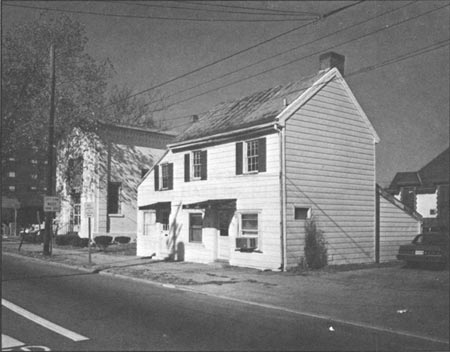|
National Park Service
Historic Themes and Resources within the New Jersey Coastal Heritage Trail Route Southern New Jersey and the Delaware Bay: Cape May, Cumberland, and Salem Counties |

|
APPENDIX 2:
STACK HOUSES
A popular vernacular residential form found throughout South Jersey is the two-story, one-pile block dubbed a stack house, which is often enlarged through the addition (or concurrent construction) of one- or two-story side sheds and/or rear ells (Fig. 128). Constructed throughout the southern and eastern portions of the United States from the late eighteenth to the mid nineteenth century, builder-occupants most commonly fit into a lower- and middle-economic strata, and reside in a rural setting.

|
| Figure 128. Typical stack house, Millville, showing the main "stacked" one-cell arrangement with shed units on the side and rear facades. |
This modest building form was often constructed by early immigrants from England, in the traditional Tidewater areas of Virginia, Maryland, Delaware, and New Jersey. It is considered a predominantly rural type, though its vertical orientation renders it convenient for narrow urban lots. In early colonial towns—Annapolis, Alexandria, and Philadelphia, for instance—it adapts to the role of a diminutive townhouse. [1]
The stack house's descriptive nomenclature is seemingly determined by its relationship to other defined house forms. The simple room arrangement is described as: two single pens set upright, one-half of an I-house, one-third of a center-hall plan, or a bandbox. [2] Simply, it is "a set of one-room modules stacked to a height of two or three stories . . . and capped with a gable roof." [3] Typical units have square or slightly rectangular proportions: 15'-6" x 15'-8" or 16'-5" x 15'-0". The main facade is two or three bays across; in the latter, the door is usually at or near the center. The single original chimney can be on the exterior or interior; the secondary chimney might be part of an addition or to vent a stove pipe. On the interior, the narrow half-turn stair is boxed—often along the fireplace wall—and a closet or storage area is underneath. Upstairs, a room was created using a thin, frame addition. A loft or attic story occupies the topmost story.
In South Jersey, a common feature is the laterally placed shed-roofed addition; these one- or two-bay units often contain a second door, which may indicate a separate service function such as store or kitchen. Occasionally the shed unit is recessed back from the main facade, and projects beyond the rear wall. The openings in these sheds appear to range from original piercings, to those reworked unsympathetically, to those closed off completely. Houses here are clad with clapboard or non-original asphaltic siding, and are uniformly devoid of ornament.
Stack houses are found in almost every small town in the NJCHT area, especially Haleyville, Mauricetown, Dorchester, Port Elizabeth, and Millville, as well as sporadically along regional roads. Geographically they mingle among other vernacular structures as well as larger elaborate, and eclectic Victorian dwellings. This simple but persistent form deserves further investigation since it was clearly a popular and long-lasting choice for a residence.
| <<< Previous | <<< Contents>>> | Next >>> |
new-jersey/historic-themes-resources/app2.htm
Last Updated: 14-Mar-2005